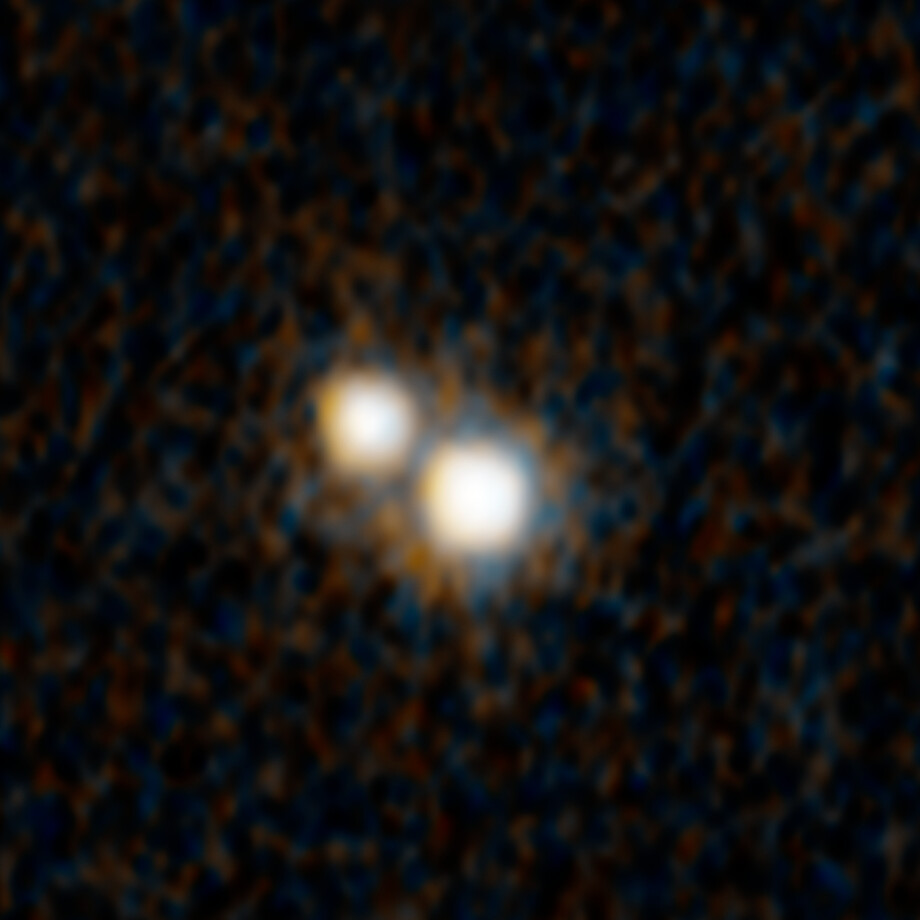IoW_20230405 - Gaia
Image of the Week
Dual quasar found to be hosted by an ongoing galaxy merger at redshift 2.17
Figure 1. This image from the NASA/ESA Hubble Space Telescope shows a pair of quasars (known as J0749+2255) that existed when the Universe was just 3 billion years old. They are embedded inside a pair of colliding galaxies. The quasars are separated by less than the size of a single galaxy. More details here and here. Credits: NASA, ESA, Yu-Ching Chen (UIUC), Hsiang-Chih Hwang (IAS), Nadia Zakamska (JHU), Yue Shen (UIUC).
Today, a Hubble Space Telescope news item reveals follow-up investigations on one of Gaia's dual quasar candidates. Initially, the source (J0749+2255) was identified as a quasar in the SDSS Legacy Survey. After Gaia's Data Release 2, with the use of Gaia's accurate astrometry, the source turned out to be part of a list of candidate dual quasars. Follow-up observations of the system by Hubble and other telescopes (Keck, Gemini, Chandra and VLA) now confirm it to be a true dual quasar and not a spurious result caused by gravitational lensing where the same quasar is seen twice due to the bending of light around a massive, unseen object between the quasar and the observer (see Shen et al. 2021). This pair of quasars is now deemed to be hosted by an ongoing galaxy merger at a redshift of z=2.17 (see Yu-Ching Chen et al. 2023).
When looking for true dual quasars, it is important to rule out the effect of gravitational lensing since a single quasar can be lensed into multiple images that appear close together on the sky. This lensing is caused by the warping of light around a massive, dark object between the quasar and the observer. In the case of a true dual quasar, one observes multiple quasars close together on the sky. In first instance, the observation of both cases might look quite similar and only with detailed follow-up observations, a definite answer can be found.
While Gaia already provides the means to find dual quasar candidates for follow-up, in the 4th quarter of 2023, Gaia will, for the first time, reveal results from its quasar environment analysis for gravitational lens search. While this new data set will bring its own excitement in the field of gravitational lensing, it will also be critical to clean up dual quasar candidate samples.
Further reading on this topic:
- Hubble Unexpectedly Finds Double Quasar In Distant Universe
- Additional info on the image
- A Close Quasar Pair in a Disk-Disk Galaxy Merger at z = 2.17 by Yu-Ching Chen et al. 2023
- Hubble Spots Double Quasars in Merging Galaxies
- A hidden population of high-redshift double quasars unveiled by astrometry by Yue Shen et al. 2021
- Gaia on the hunt for dual quasars and gravitational lenses
- Unveiling the population of dual and lensed active galactic nuclei at sub-arcsec separations by Mannucci et al. 2022
- 12 rare Einstein crosses discovered with Gaia
- Lensing explained
- Gaia's upcoming Focused Product Release will contain the first results of quasars' environment analysis for gravitational lenses search
Credits: Story written by Tineke Roegiers and Jos de Bruijne, largely based on the NASA press release.
[Published: 05/04/2023]
- Removed a total of (6) style text-align:center;
- Removed a total of (4) style text-align:justify;
Image of the Week Archive
- Removed a total of (1) border attribute.
- Removed a total of (1) cellpadding attribute.
- Removed a total of (1) cellspacing attribute.








































 Sign in
Sign in
 Science & Technology
Science & Technology
